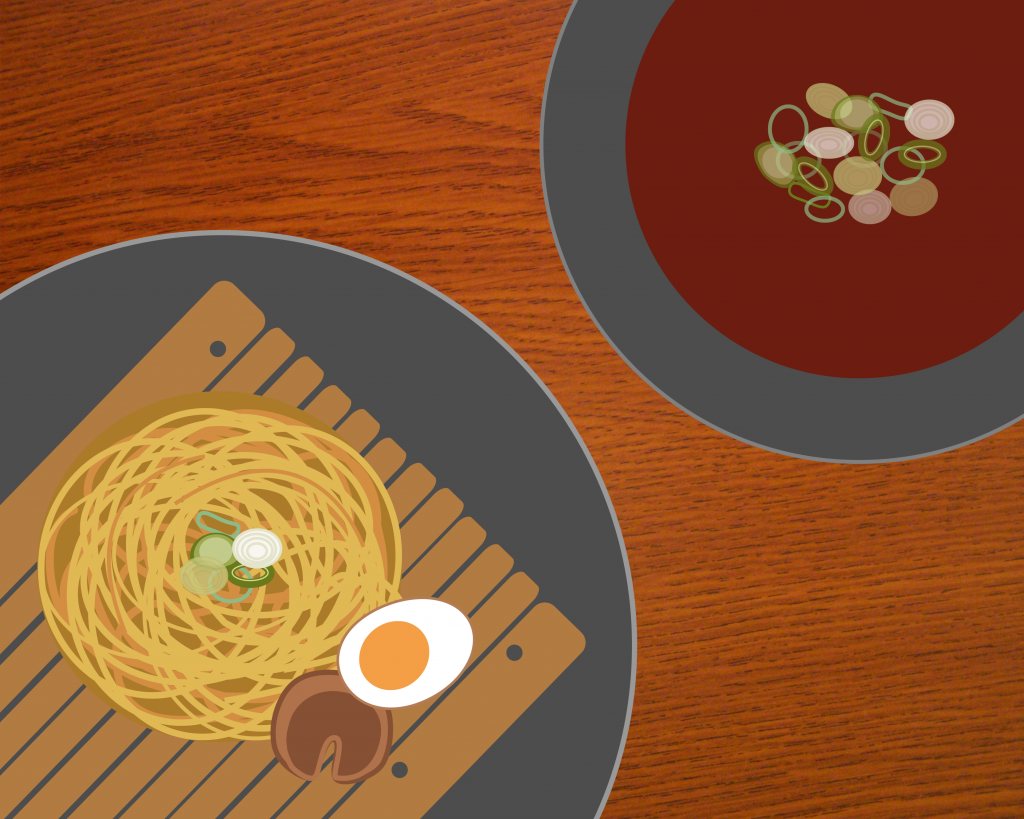By YOUNGSEO JHE, ANDREA KWON
Opening the heavy door to Soraya, the doorbell chimed in a high clear note. As we entered, we were welcomed into a small traditionally-styled store full of references to Japanese culture. The large paper lanterns on the ceiling softly lit the restaurant as the wooden walls enhanced the traditional atmosphere. Pop songs that echoed through the store and the stacks of popular Japanese comic books on its shelves added a more modern aspect to Soraya. With two bowls of ramen served in a china bowl, the restaurant also brought together Japan’s unique culture.
Contrary to popular belief, ramen originated not in Japan but in China. The most plausible tale of its origin states that ramen was a Chinese noodle soup that spread to Japan through 19th-century tradesmen. When it was first introduced to Japan, ramen was not even remotely similar to what we now know it to be. For one, it did not contain toppings and was served as a post-meal dish instead of an entrée. In fact, present day ramen was birthed in the early 20th century. Keeping pace with Japan’s rapid industrialization during the time, ramen began to grow in popularity as a fast food. The dish acquired an elevated culinary status as it transformed into an artisanal food in the post-World War II years. Today, hand-made ramen in Japan is strongly associated with a sense of craftsmanship and Japanese culture.
Visiting Soraya, a restaurant specializing in ramen, we anticipated finding the authentic Japanese taste that expert ramen makers take great pride in. The store had received numerous positive reviews online, many complimenting its modest prices and ample servings.
After leading us to our seats, the waiter set down some yellow radish and kimchi as sides while we scanned the menu. Instead of having confusingly many items, the menu contained concise descriptions, facilitating the process of deciding what to order. After a thorough look at a menu, we decided to order tonkotsu ramen and tsukemen along with torikarage.
Though all the dishes quickly came out at once, we decided to try the torikarage first as an appetizer. Comparable to Korean marinated fried chicken, the torikarage had a soft yet crispy outer layer. As the crunchy chicken gave a savory taste to the dish, the sweet tonkatsu sauce along with mayonnaise generated a perfect amalgamation of sweet and salty flavors. The well-cooked and soft chicken meat paired well with the crisp of the outer layer.
After wolfing down the torikarage, we moved on to the entrée dishes. We commenced our meal with the tonkotsu ramen, which was savory and rich. A mouthful of steaming broth and noodles and cold half-boiled egg created an exploding sensation of flavor. The bean sprout topping complemented the oily soup very nicely by leaving behind a taste of freshness.
In contrast to the tonkotsu, the tsukemen was a ramen with a distinctive piquant taste. Whereas most ramen noodles come out of the kitchen submerged in the broth, tsukemen was unique in that its noodles were laid out on another plate. The process of eating was unlike any other; we dipped the noodles into the hot broth and ate them like soba.
Although both menus were savory and flavorful, the tsukemen’s spice overrode the mild tonkotsu ramen. Soon after trying both, we found that it was harder to taste the tonkotsu ramen because of the tsukemen. The noodles of the tonkotsu ramen became a bland noodle dish that had lost much of its pork broth flavor. We recommend that you finish tonkotsu ramen before diving into the tsukemen, as the pork ramen’s assets could not be fully appreciated with the stronger presence of the spicy noodles.
In all honesty, it is difficult to say that Soraya fully lived up to our expectations of tasting authentic Japanese ramen. The food served at Soraya was overall very sweet, unlike most other ramen dishes in the market. With the exception of the tonkotsu, everything from the torikarage and the tsukemen to even the kimchi had a slightly sweet flavor. Spicy and sweet was definitely an unorthodox combination for a ramen dish. While we enjoyed the meal and felt like the unusual flavor contributed to making the restaurant more special, we did note that some people definitely would not favor the taste.
Soraya is a restaurant we give positive marks to overall, especially because of its uniqueness and highly affordable prices. We were charged a total of ₩18,000 for three menus, which is considerably cheaper than the majority of Japanese eateries in Korea. For anyone looking to eat at a casual yet appetizing place, we would definitely recommend the small store of Soraya.

